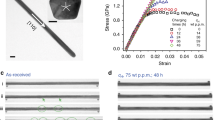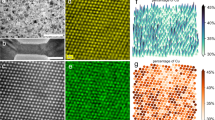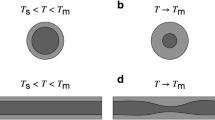Abstract
Several researchers1,2,3,4,5,6,7,8 have demonstrated, through experiments and analysis, that the structure and properties of nanometre-scale materials can be quite different to those of bulk materials due to the effect of surfaces. Here we use atomistic simulations to study a surface-stress-induced phase transformation in gold nanowires. The emergence of the transformation is controlled by wire size, initial orientation, boundary conditions, temperature and initial cross-sectional shape. For a <100> initial crystal orientation and wire cross-sectional area below 4 nm2, surface stresses alone cause gold nanowires to transform from a face-centred-cubic structure to a body-centred-tetragonal structure. The transformation occurs roughly when the compressive stress caused by tensile surface-stress components in the length direction exceeds the compressive stress required to transform bulk gold to its higher energy metastable crystal structure.
This is a preview of subscription content, access via your institution
Access options
Subscribe to this journal
Receive 12 print issues and online access
$259.00 per year
only $21.58 per issue
Buy this article
- Purchase on Springer Link
- Instant access to full article PDF
Prices may be subject to local taxes which are calculated during checkout



Similar content being viewed by others
References
Kondo, Y., Ru, Q. & Takayanagi, K. Thickness induced structural phase transition of gold nanofilm. Phys. Rev. Lett. 82, 751–754 (1999).
Hasmy, A. & Medina, E. Thickness induced structural transition in suspended fcc metal nanofilms. Phys. Rev. Lett. 88, 096103 (2002).
Kondo, Y. & Takayanagi, K. Gold nanobridge stabilized by surface structure. Phys. Rev. Lett. 79, 3455–3458 (1997).
Kondo, Y. & Takayanagi, K. Synthesis and characterization of helical multi–shell gold nanowires. Science 289, 606–608 (2000).
Gülseren, O., Ercolessi, F. & Tosatti, E. Noncrystalline structures of ultrathin unsupported nanowires. Phys. Rev. Lett. 80, 3775–3778 (1998).
Tosatti, E., Prestipino, S., Kostlmeier, S., Dal Corso, A. & Di Tolla, F.D. String tension and stability of magic tip-suspended nanowires. Science 291, 288–290 (2001).
Hall, B.D., Flüeli, M., Monot, R. & Borel, J.–P. Multiply twinned structures in unsupported ultrafine silver particles observed by electron diffraction. Phys. Rev. B 43, 3906–3917 (1991).
Marks, L.D. Surface structure and energetics of multiply twinned particles. Philos. Mag. A 49, 81–93 (1984).
Van Hove M.A. et al. The surface reconstructions of the (100) crystal faces of Iridium, Platinum and Gold. Surf. Sci. 103, 189–217 (1981).
Yamazaki K., Takayanagi, K., Tanishiro, Y. & Yagi, K. Transmission electron microscope study of the reconstructed Au(100) surface. Surf. Sci. 199, 595–608 (1988).
Fiorentini, V., Methfessel, M. & Schoffler, M. Reconstruction mechanism of fcc transition metal (001) surfaces. Phys. Rev. Lett. 71, 1051–1054 (1993).
Binnig, G.K., Rohrer, H., Gerber, Ch. & Stoll, E. Real-space observation of the reconstruction of Au(100). Surf. Sci. 144, 321–335 (1984).
Gibbs, D., Ocko, B.M., Zehner, D.M. & Mochrie S.G.J. Absolute x-ray reflectivity study of the Au(100) surface. Phys. Rev. B 38, 7303–7310 (1988).
Baskes, M.I. Modified embedded-atom potentials for cubic materials and impurities. Phys. Rev. B 46, 2727–2742 (1992).
Baskes, M.I., Angelo, J.E. & Bisson, C.L. Atomistic calculations of composite interfaces. Model. Simul. Mater. Sci. Eng. 2, 505–518 (1994).
Kelchner, C.L., Plimpton, S.J. & Hamilton, J.C. Dislocation nucleation and defect structure during surface indentation. Phys. Rev. B 58, 11085–11088 (1998).
Hahn, E., Kampshoff, E., Wälchli, N. & Kern, K. Strain driven fcc-bct phase transition of pseudomorphic Cu films on Pd(100). Phys. Rev. Lett. 74, 1803–1806 (1995).
Streitz, F.H., Cammarata, R.C. & Sieradzki, K. Surface-stress effects on elastic properties. I. Thin metal films. Phys. Rev. B 49, 10699–10706 (1994).
Acknowledgements
The work was supported by Sandia National Laboratories and the National Science Foundation, USA. The authors thank Jon Zimmerman for his insightful discussions and guidance.
Author information
Authors and Affiliations
Corresponding author
Ethics declarations
Competing interests
The authors declare no competing financial interests.
Supplementary information
Rights and permissions
About this article
Cite this article
Diao, J., Gall, K. & Dunn, M. Surface-stress-induced phase transformation in metal nanowires. Nature Mater 2, 656–660 (2003). https://doi.org/10.1038/nmat977
Received:
Accepted:
Published:
Issue Date:
DOI: https://doi.org/10.1038/nmat977
This article is cited by
-
Chemical inhomogeneity–induced profuse nanotwinning and phase transformation in AuCu nanowires
Nature Communications (2023)
-
Role played by phonon drag on accuracy of MD simulations of nanowires due to deficiently selected strain rates
International Journal of Mechanics and Materials in Design (2023)
-
Catalyst-free synthesis of sub-5 nm silicon nanowire arrays with massive lattice contraction and wide bandgap
Nature Communications (2022)
-
An approach to calculate surface effects of polyhedron nanocrystals and its application in silicon nanowires
Acta Mechanica Sinica (2022)
-
Intrinsic toughening and stable crack propagation in hexagonal boron nitride
Nature (2021)



